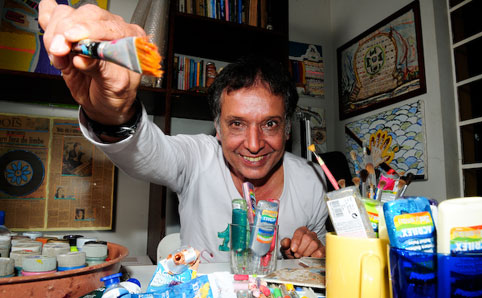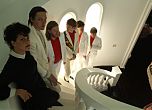
The creative process takes some artists along the road less travelled, defying the restrictions of form, style, composition and genre. Composer, multi-instrumentalist and an ex-member of the seminal Brazilian band Os Mutantes, Arnaldo Baptista has gone down that very road, in a journey that has paved the way for translating his diverse inspirations onto canvas. From 24 March to 20 April 2012, Emma Thomas gallery hosts Baptista’s first major solo art exhibition, entitled ‘Lentes Magnéticas’ (‘Magnetic Lenses’). A total of 120 works will be shown, offering a broad overview of Baptista’s artistic process over the last thirty years. ‘The exhibition will be something like a wide-angle view of my life,’ says Baptista. The show’s content is also set to be released in 2013, in a book that will bring together images and descriptions of his many works.
The exhibition includes drawings and paintings in acrylic, nankeen ink and watercolours, as well as collages. The works transport the viewer to a universe that materialises through Baptista’s depictions of faces, animal figures, dreamlike landscapes, words and phrases – all with a discernibly psychedelic edge. His collages incorporate several recycled elements, such as the rubber lining from a pressure cooker and the feathers from old dusters. Emma Thomas gallerist Juliana Freire compares his painting style to the Art Brut movement of artists like Henry Darger. And how does the artist define it? ‘Exorealism’, declares Baptista, who works out of a studio in the city of Juiz de Fora, Minas Gerais, where he lives. He spoke to Time Out during one of his recent visits to São Paulo to prepare for the exhibition’s opening.
This is your first major solo exhibition, and it spans a huge range of your artistic work. Could you comment on that?
As a musician, I’ve had one foot in the door of the contemporary art scene for quite some time. I've recorded more than a hundred songs in total – I counted the other day. But my work in the fine arts scene in particular isn't as well known toy the general public. I’m hoping that this solo exhibition will help expose my other artistic side. I’ve included works from my first stages of painting, from when I started out. The exhibition will cover all aspects of my creativity: from engines to science fiction, bodies, beauty, and different painting styles. I want it to be something that captures my life as a visual artist threough a wide angle.
 |
| From Lentes Magnéticas (1994), drawing and collage, 22 x 30 cm |
Your work includes a lot of portraits. What makes you interested in painting people?
It’s interesting how in contemporary art, we sometimes translate something to the canvas that we aren’t even aware is taking place in our hearts, you know? For instance, I don’t consider myself an artist who’s very good at painting faces – I never studied the technique. There are issues of getting the right oval shapes, specific ways of perceiving the physiognomy, the characteristics ... I'm trying to develop the thing I find to be my greatest weakness.
What about about your art-making process? Do you paint every day?
My fine arts side was closeted when I lived with my mother and father ... I didn’t have canvases, paints, or a studio. I only started to develop an affinity for the visual arts when I started living with Lucinha [Barbosa, his wife]. I came to have a home and a life more dedicated to art – with paints, an easel, canvases, space, adequate lighting. It’s very important to me in a more personal way, it’s a part of my being. When I was a child, I’d wake up in the small hours of the morning. I remember how I used to sit there, listening to the clock ticking – it was really hard to make the time pass. But now I spend all those waking hours painting, so this time of the day has become essential to my art. That’s how I’m repaid in life, in the most profound way.



